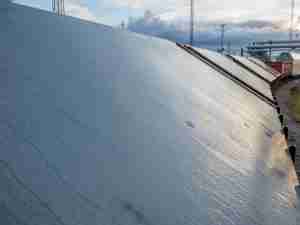President Donald Trump said on Wednesday that Americans can no longer live with crumbling locks, dams, roads and bridges and outlined a plan to leverage $1 trillion in investment in U.S. infrastructure.
Speaking at a marina in Cincinnati on the banks of the Ohio River with a coal barge behind him, Trump vowed that “America wants to build.”
“America must have the best, fastest and most reliable infrastructure anywhere in the world,” he said. “We cannot accept these conditions any longer.’’
Trump did not provide any new details of his plan. His budget proposal for fiscal 2018 calls for $200 billion in direct federal spending over the next 10 years to spur at least $800 billion in spending by states, municipalities and private entities that together own most U.S. infrastructure.
The White House has not detailed the source of the $200 billion or the breakdown in spending. The administration has said a full legislative package could be ready by the third quarter.
Democrats, some Republicans and groups representing the nation’s governors and mayors have said much more than $200 billion in direct federal spending over 10 years is needed to meet the nation’s needs—and that relying on states, municipalities and the private sector won’t get needed work done.
Calling Congressional Democrats “obstructionists,” Trump nonetheless said Wednesday he wants them to help pass his infrastructure plan.
“I’m calling on all Democrats and Republicans to join together, if that’s possible, in the great rebuilding of America,’’ Trump said.
How ‘Self-Help’ Guides Trump Infrastructure Plan: QuickTake Q&A
Trump distinguished his approach from President Barack Obama’s $787 billion stimulus bill in 2009, saying his plan focuses on accountability for federal tax dollars rather than substituting federal highway dollars for state dollars.
The plan also calls for spurring investment by reducing the time to secure needed regulatory approvals and permits from about 10 years to two years, Trump said. He said the Golden Gate Bridge was built in four years and the Hoover Dam in five.
According to the White House, the federal funding in Trump’s plan would be divided into four categories:
- A mixture of grants and loans to “transformative’’ projects, with Trump’s proposal to place the U.S. air-traffic control system under a private, non-profit corporation as an example.
- Grants to rural areas to repair bridges, roads, and waterways. Critics of Trump’s approach have raised concerns that rural areas would not be able to rely on tolls or fees to attract private investment.
- Enhanced loan programs, with the Transportation Infrastructure Finance and Innovation Act, or TIFIA, as an example of how federal funds can be used with state, local, and private dollars to fund projects.
- Incentive programs with grants to states and municipalities to create additional funding for infrastructure.
‘Screeching Halt’
The president said the goal is to give states and localities the ability to address their own infrastructure needs and to collaborate with private enterprises where it makes sense.
“The theft of American prosperity has come to a screeching halt, and a new era of America greatness is about to begin,’’ Trump said.
One focus of the work, Trump said, should be the 12,000 miles of inland waterways in the U.S., which are critical for the movement of goods such as grain, coal and steel—hence his backdrop on the Ohio River.
Deb Calhoun, senior vice president of Waterways Council Inc., a group representing shippers, said many of them don’t like one element of the president’s plan: a proposed a fee for waterways users to generate more than $1 billion over 10 years.
While the administration hasn’t provided details, operators fear that fee will involve tolls or other charges to replace the 29-cent-per-gallon diesel tax they now pay toward a trust fund for waterways improvements, Calhoun said. Trump’s fee could be twice as much, she said.
“When you’re talking about a potential doubling of what inland operators pay, it’s not fair and it’s not equitable,’’ Calhoun said.






